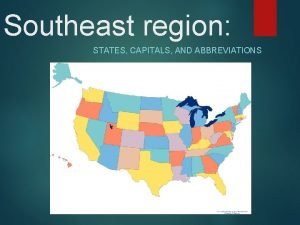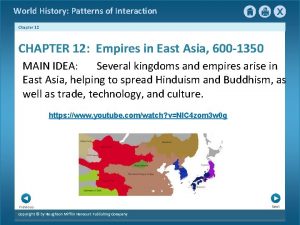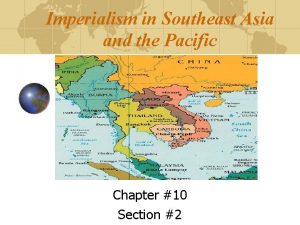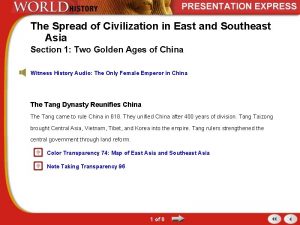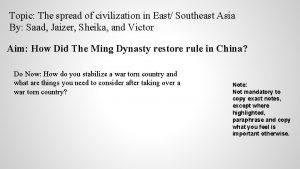The Spread of Civilization in East and Southeast








- Slides: 8

The Spread of Civilization in East and Southeast Asia Section 4: The Emergence of Japan and the Feudal Age Witness History Audio: The Importance of Harmony Geography Sets Japan Apart Japan is a chain of islands east of the Korean peninsula. Its people live in river valleys and along coastal plains. The isolation has helped Japan to preserve is culture. Japan’s location along the Ring of Fire subjects it to frequent volcanic eruptions and earthquakes. Geography Interactive: Early Japan Note Taking Transparency 99 1 of 8

The Spread of Civilization in East and Southeast Asia Section 4: The Emergence of Japan and the Feudal Age Early Traditions The early Japanese were divided into clans. The Yamato clan came to power on Honshu about A. D. 500. The Japanese worshipped gods and goddesses and the forces of nature. Japan had a frequent contact with Korea and adopted some aspects of Korean culture and technology. Japan Looks to China Many Japanese visited China between 600 and 800. The Japanese adopted Chinese ideas about government. The Japanese capital at Nara was modeled after that of the Tang, and Chinese food and music were popular there. The Japanese never adopted the civil service system, however. Color Transparency 75: Chinese Influence in Its Neighbors 2 of 8

The Spread of Civilization in East and Southeast Asia Section 4: The Emergence of Japan and the Feudal Age The Heian Period When the imperial capital was in Heian (from 794 to 1185), a sophisticated culture was established with strict rules of etiquette. Heian writers wrote poems, romances, and the first novel. Warriors Establish Fuedalism Feudalism emerged in the 1400 s, with shoguns giving land to daimyo, who then gave land to samurai in return for protection. With feudalism came a loss of rights for women. Japan was able to avoid Mongol rule when typhoons twice prevented Mongol fleets from making landfall. Witness History Video: The Samurai of Japan 3 of 8

The Spread of Civilization in East and Southeast Asia Section 4: The Emergence of Japan and the Feudal Age The Tokugawas Unite Japan The daimyo Tokugawa Ieyasu ruled Japan beginning in 1600. Tokugawa shoguns strengthened the central government. They brought the daimyo to the capital, where they could be monitored. With peace came a booming economy and flourishing trade. Zen Buddhism Shapes Culture Zen Buddhism came to Japan from China and was first adopted by the Samurai. However many Zen ideals, such as compassion, were not those of the Samurai. 4 of 8

The Spread of Civilization in East and Southeast Asia Section 4: The Emergence of Japan and the Feudal Age Artistic Traditions Change The Noh plays that developed under feudalism often presented Zen themes. The later dramatic form called Kabuki included comedies and melodramas. Japanese artists created landscape paintings and woodblock prints. Quick. Take Section Quiz Progress Monitoring Transparency 5 of 8

The Spread of Civilization in East and Southeast Asia: Section 4 Note Taking Transparency 99 6 of 8

The Spread of Civilization in East and Southeast Asia: Section 4 Color Transparency 75: Chinese Influence on Its Neighbors 7 of 8

The Spread of Civilization in East and Southeast Asia: Section 4 Progress Monitoring Transparency 8 of 8
 East is east and west is west
East is east and west is west Horizontal movement of air is called
Horizontal movement of air is called Kalahari desert on africa map
Kalahari desert on africa map Southeast region map with capitals and abbreviations
Southeast region map with capitals and abbreviations Insular and mainland southeast asia
Insular and mainland southeast asia Chapter 12 section 5 kingdoms of southeast asia and korea
Chapter 12 section 5 kingdoms of southeast asia and korea Imperialism in southeast asia and the pacific
Imperialism in southeast asia and the pacific Hát kết hợp bộ gõ cơ thể
Hát kết hợp bộ gõ cơ thể



